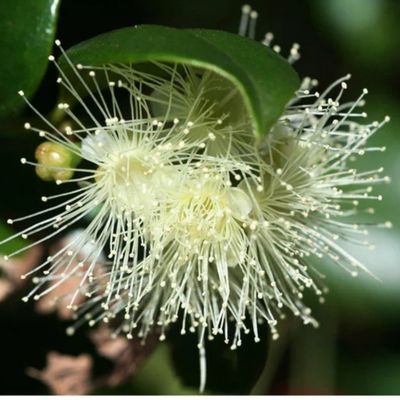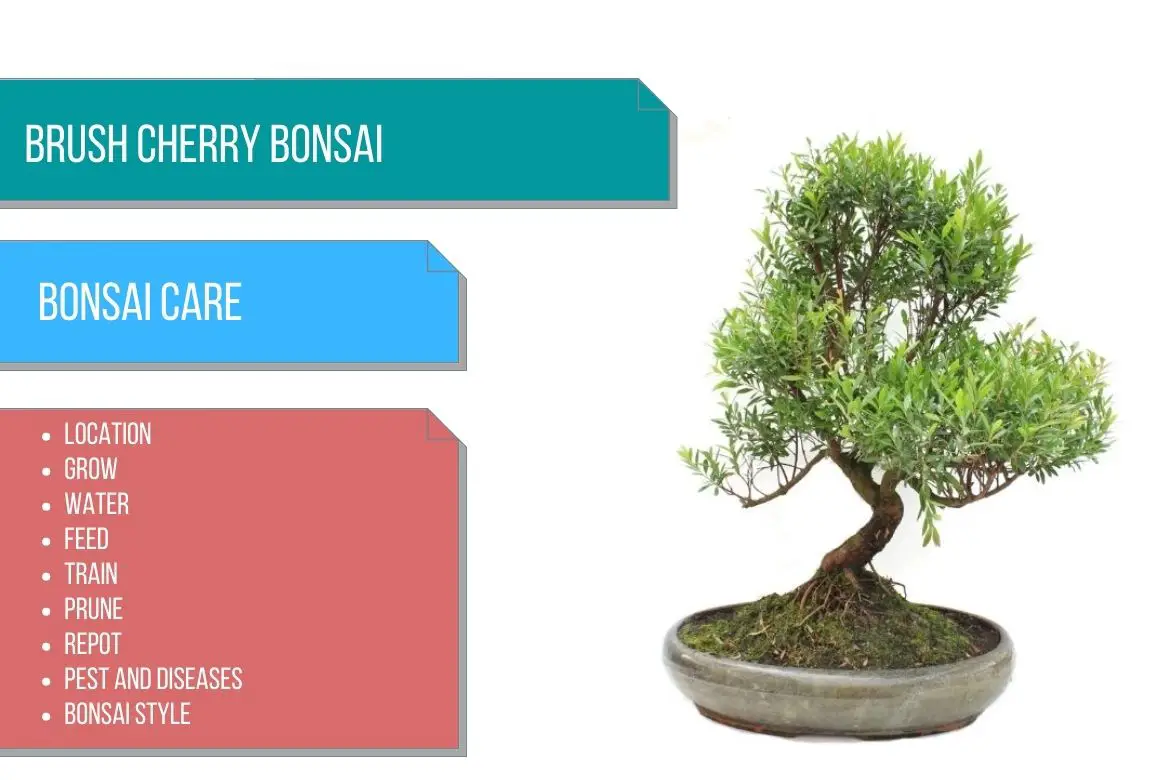
Brush Cherry
(Syzygium paniculatum)
Country of Origin : Australia & New Zealand
Bonsai Styles : Informal upright, Forest style
Zone : 6 – 12
Brush Cherry tree, formerly also known as ‘Eugenia paniculata‘ or just ‘eugenia‘, is an evergreen shrub.
Its natural bushy growth habit along with small glossy dark green leaves make this tree suitable for medium to small bonsai specimens.
Its leaves are ovate and borne in pairs.
Occasionally in the months of Spring, the tree produces tiny white ‘powder-puff’ like flowers. These flowers are followed by red fruits which look like cherries. (Also refer powder puff bonsai tree).
Bonsai cultivars with small leaves are particularly popular to make bonsai.
A brush cherry bonsai cultivar named ‘Teenie Genie‘ is popular with bonsai enthusiasts because of its compact growth rate and much smaller leaves, which are only about a quarter-inch long.

These red berries are not poisonous. These berries are edible and are specially liked by birds.

‘Powder puff‘ like flowers of Brush Cherry bonsai tree.
Best location to keep Brush Cherry Bonsai
Brush cherry bonsai does well in bright light. Hence, keeping it outdoors is a good idea.
However, this bonsai tree can also be grown as an indoor bonsai. Provided the container is kept at a location with ample sunlight (For e.g. South or west facing window or windowsill).
In summers it wont have any issues till it is exposed to good sunlight. 70°F (21°C) to 85°F (29°C) of a temperature range is advisable.
In winter, keep the bonsai indoors, protected from the frost. It will do well in a temperature range of about 55°F (12°C) to 65°F (18°C).
When ever the temperatures ( specially in the night time) fall below 50°F (10°C), move the bonsai pot to a protected shed.
Refer sunlight requirements for indoor plants for more indoor gardening ideas. Also, refer to do bonsai trees need sunlight for more indoor and outdoor bonsai location ideas.
Propagation of Brush Cherry tree
Brush cherry tree can be propagated using seeds and stem cuttings.
Seeds might take up to 6 months to germinate hence i would recommend using a stem cutting if possible.
Stem cuttings generate roots quite easily. Most of the times you do not even have to use a rooting hormone for the stems to root.
Watering Brush Cherry Bonsai
Syzygium paniculatum bonsai trees are thirsty, specially in the months of summer.
You can use tap water. However, make sure that your water is not saline or calcium-rich. Using rain water is the best option if it is possible.
Water the plant when the bonsai soil feels dry to the touch. But don’t let it get bone dry.
In summer, especially when the bonsai is kept near a window with glass, you will experience some increase in watering frequency.
Don’t allow the soil to become water logged, and don’t allow it to become bone dry either.
Also, brush cherry trees do well in slight humid conditions as well. So, spraying some water on the bonsai tree can also be done. However, it is optional.
Do not water the tree from the top when the tree is flowering. The flowers may wilt and drop.
Read watering bonsai tree for more details about immersion technique.
Wiring Brush Cherry Bonsai
It is possible to wire train brush cherry bonsai tree at any time of the year. Wiring it in the active growing season is advisable.
This tree has fairly flexible branches, which make it easy to work with. However, it also scars easily. Hence, wire very carefully.
Use the thinnest guy wire. And keep a close eye on the wires. Make sure that they are not biting on to the bark of the tree.
Wire training the branch can be achieved in about 2 months. So don’t leave the wire on the tree for too long.
You just need to be aware of its thorns.

One advantage of growing brush cherry bonsai tree is, its a quick grower, which gives you the option on achieving your desired shape by pruning in case you do not wish to wire train the tree.
Pruning Brush Cherry Bonsai
When to prune Brush Cherry bonsai?
How to prune Brush Cherry bonsai?
You will need to prune this tree back hard and remove all or most of the foliage in order to develop its shape.
This is due to the fact that this tree is a vigorous grower.
When you prune hard, you will get lots of buds, which will result in healthy growth.
As a result of removing the foliage, more light is allowed into the interior of the tree. This contributes to the development of bud formation close to the core of the tree, which is very helpful for encouraging dense branching and a strong trunk.
As soon as six to eight leaf pairs have grown on the new shoots, shorten the new shoots to one or two leaf pairs.
The most appropriate time for major pruning is in early summer, when the tree is growing at its fastest pace.
Pruning back new growth on a regular basis will help to maintain the shape and style of the tree.
Note : The pruning wounds on the tree don’t heal well. So make sure you prune carefully.
Repotting Brush Cherry Bonsai
When to repot Brush Cherry bonsai?
Repot the brush cherry bonsai tree every 1-2 years in spring. When the tree is in active growth season.
This tree produces a lot of fibrous roots.
While repotting, prune the roots of the tree as well. Do not remove more than 1/3 of the root system.
You can use a free-draining, bonsai soil mix. You can use slightly acidic soil.
Avoid feeding the tree for almost a month after repotting. However, give adequate amount of water.
Must Read: Bonsai Soil Recipes
Must read : Choosing the right bonsai container
Feeding Brush Cherry Bonsai
With a balanced fertilizer at half strength, you should fertilize your bonsai tree on a weekly basis.
Fertilizing should be reduced to once every two to three weeks during the winter months.
The soil can also be acidified by applying a soil acidifier.
Read more about bonsai fertilizer and its application.
Diseases and pest of Brush Cherry Bonsai
Sap sucking insects such as scales, whiteflies, aphids, spidermites and ‘eugenia psyllid‘ can infect eugenia bonsai tree.
Aphids and spidermites can be removed manually. Or you can use a systemic insecticide. or you can use a gentle water spray to dislodge them from the tree.
This dark-brown psyllid has a white band around its abdomen. Approximately 1/10 to 1/5 inch long, the pest lays gold-colored eggs near leaf edges.
The bug usually feeds on new leaves, causing pits. Infested eugenia foliage has reddish or distorted areas near feeding pits.
You can treat it with an appropriate insecticide or use a solution of water (1 gallon) and need oil (2 tablespoons).
For scales and whiteflies, you can use any insecticide (mix few drops of soapy water in it. It will help the insecticide penetrate the outer shell of the pest)
Honeydew and sooty mold can also be caused by infestation of sap sucking insects. Use a gentle water jet to remove the patches. Eliminating other pests from the tree will also reduce the chances of honeydew and sooty mold.
Brush Cherry bonsai care
Move the bonsai container to a warmer place when the temperature falls below 40°F (4°C). Or else the tree will suffer from frost damage.
Water logged soil is more dangerous to the eugenia bonsai tree than dry soil. Poor draining and water logging of the soil will cause the roots to rot.
If you are a beginner, it is recommended that you start with nursery stock, soft wood cuttings taken during active growth.
Ideally, you should be looking for a bonsai specimen with small leaves that are about an inch long.

